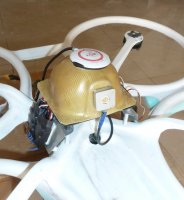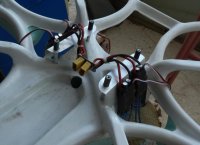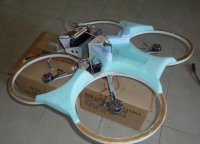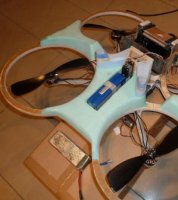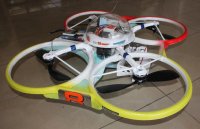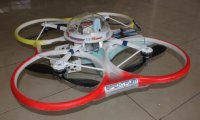A few construction shots of one of the F-1's this one has a Naza another has WKM and another has APM-02 which is starting to look very promising as a new contender for top spot. View attachment 2541View attachment 2542View attachment 2543View attachment 2544
You are using an out of date browser. It may not display this or other websites correctly.
You should upgrade or use an alternative browser.
You should upgrade or use an alternative browser.
The F1 -535 White Knight revealed
- Thread starter DennyR
- Start date
gadgetkeith
likes gadgets
Looking good DennyR
nice and sleek whats frame made of looks like some sort of abs or polymer
cant wait to see it in action
nice work
keith
nice and sleek whats frame made of looks like some sort of abs or polymer
cant wait to see it in action
nice work
keith
.Wow, that looks brilliant! I expect it has taken many hours to build?
Gunter.
Thanks Guys
The lay-up of each frame takes about one week to build as it is a composite of end grain soft balsa, carbon, Kevlar, foam board and some alum, hard points. The molds to create it took considerably longer. No steel fasteners anywhere. Weight is the enemy. The plan is to sell a few to high end users but at this moment in time it would be far too expensive for the average hobby modeler. But when you take into account the high cost of some of these heavy lift Oktos that are around then perhaps it will not be considered that expensive after all.
It is a flying camera where the operator steers the camera and the model follows with high precision.
Floatation panels can be easily replaced as they get soiled with use. These are not designed for take off over water as their function is to allow the user to retrieve it should it run out of power over water. It is not therefore a totally waterproof solution as the camera is not waterproof. More follows!!!
It has rained here for the last six weeks which has hampered progress on the flight demos. Normally see a ten min. shower once a year.
The shrouded rotors are primarily a safety feature but as the carbon props are going to be expensive to autoclave they are also a cost saver.
Last edited by a moderator:
Not quite ready to reveal that little secret just yet but the Tx input steers the camera as a primary action. View attachment 2546 This is the second battery bay.
Attachments
View attachment 2734View attachment 2735
Herewith a couple more shots of what a finished one looks like.:tennis:
Herewith a couple more shots of what a finished one looks like.:tennis:
Attachments
Paramount to stabilisation at this level is the torsional rigidity of the arms and the weight of the props. You cant do this with motors on a long stick whatever you do electronically.
Balance is not just about static balancing of your props. when the model gets into a descent with turbulence it will create partial stalls and uneven lift along the blade. This results in aerodynamic vibration which requires more rigidity than can be found with long upright motors on a long thin carbon arm. Once the motor moves off axis then heavy vibration occurs which is augmented and picked up by the sensors. DJI arms are made the way they are for this reason.
Balance is not just about static balancing of your props. when the model gets into a descent with turbulence it will create partial stalls and uneven lift along the blade. This results in aerodynamic vibration which requires more rigidity than can be found with long upright motors on a long thin carbon arm. Once the motor moves off axis then heavy vibration occurs which is augmented and picked up by the sensors. DJI arms are made the way they are for this reason.
Last edited by a moderator:
charlie soppelsa
Member
Have you missed a trick ? If your shrouds had bellmouths you could get another 30% lift for no extra power. I know there can be a problem with assymetrical lift in side winds or forward flight as Mr Hiller discovered but that is easily solved.
Ah! another case of someone trying to change the laws of physics. If you believe that you will believe anything.
I have played with bell mouth designs for a very long time. It was the fundamental element in the design of air intake systems on formula 3 race engines where all of the air that the engine breaths has to pass through a restrictor. That shape is cast in stone. All of the engine manufacturers including myself came up with the same solution from 1970 until today.
There is no such 30% mass flow improvement possible, that is just a myth. The top surface area that has been used here is as large as is practical, anything larger just adds weight. The velocity of flow is not high enough to generate any such improvement. There are shapes that could loose some efficiency especially tubes that contain the rotors. however. My design from last year had a bell mouth and it was changed to save weight. Several other lifting devices and principles were also abandoned as they affected stability.
I have played with bell mouth designs for a very long time. It was the fundamental element in the design of air intake systems on formula 3 race engines where all of the air that the engine breaths has to pass through a restrictor. That shape is cast in stone. All of the engine manufacturers including myself came up with the same solution from 1970 until today.
There is no such 30% mass flow improvement possible, that is just a myth. The top surface area that has been used here is as large as is practical, anything larger just adds weight. The velocity of flow is not high enough to generate any such improvement. There are shapes that could loose some efficiency especially tubes that contain the rotors. however. My design from last year had a bell mouth and it was changed to save weight. Several other lifting devices and principles were also abandoned as they affected stability.
Last edited by a moderator:
Bartman
Welcome to MultiRotorForums.com!!
Have you missed a trick ? If your shrouds had bellmouths you could get another 30% lift for no extra power. I know there can be a problem with assymetrical lift in side winds or forward flight as Mr Hiller discovered but that is easily solved.
like Denny said Charlie, the airflow velocity is too low. when air approaches the speed of sound, mach 1, it doesn't flow as easily and begins to get bunched up or compressed. the bell housings take that flow and give it the optimum inlet path to get as much air as possible through an opening as close to mach 1 as possible but that's it. there are very old and very well vetted charts that help designers accomplish this.
getting air to be a little more organized flowing into a propeller might be worth a very small percentage efficiency increase but it's tough to justify it given the weight to make it happen. guide vanes between the props of a coaxial arrangement might help prop efficiency also but they'd probably introduce enough airframe vibration so as to make any efficiency gain meaningless.
charlie soppelsa
Member
Denny, don't be patronizing, I'm not changing any physical laws. The Bernoulli principle can be applied even with the small propellors we use in multicopters and at reasonable delta V's.
For example I have a 9x6 APC E prop driven from a AXI2212/34 running off 4S, to produce 400grm thrust it uses 72 watts. I have a test bellmouth 9" ID x 12" OD made from Blue foam turned on a lathe and glassed it weighs 36 grms. With this Bellmouth the power required to produce 400 grms reduces to 45 watts. If you do the maths it shows a clear benefit.
Your reference to F3 engines relates to the venturi effect which is a different application of the Bernoulli principle.
Please understand that my original comment was to offer a constructive and useful contribution and not to criticise your design in any way.
For example I have a 9x6 APC E prop driven from a AXI2212/34 running off 4S, to produce 400grm thrust it uses 72 watts. I have a test bellmouth 9" ID x 12" OD made from Blue foam turned on a lathe and glassed it weighs 36 grms. With this Bellmouth the power required to produce 400 grms reduces to 45 watts. If you do the maths it shows a clear benefit.
Your reference to F3 engines relates to the venturi effect which is a different application of the Bernoulli principle.
Please understand that my original comment was to offer a constructive and useful contribution and not to criticise your design in any way.
Bartman
Welcome to MultiRotorForums.com!!
Denny, don't be patronizing, I'm not changing any physical laws. The Bernoulli principle can be applied even with the small propellors we use in multicopters and at reasonable delta V's.
For example I have a 9x6 APC E prop driven from a AXI2212/34 running off 4S, to produce 400grm thrust it uses 72 watts. I have a test bellmouth 9" ID x 12" OD made from Blue foam turned on a lathe and glassed it weighs 36 grms. With this Bellmouth the power required to produce 400 grms reduces to 45 watts. If you do the maths it shows a clear benefit.
Your reference to F3 engines relates to the venturi effect which is a different application of the Bernoulli principle.
Please understand that my original comment was to offer a constructive and useful contribution and not to criticise your design in any way.
charlie,
i'd be interested to see pics if you're comfortable sharing your work. i'd guess the bellmouth is increasing the efficiency of the propeller tips. sorta like winglets on an airplane wing.
thanks,
bart
charlie soppelsa
Member
Bart
As you can see it ain't rocket science. I agree that it also reduces tip losses and this adds to efficiency also, in fact the 9" prop is cut down to 8.75" to square off the tips, this helps.View attachment 2740
As you can see it ain't rocket science. I agree that it also reduces tip losses and this adds to efficiency also, in fact the 9" prop is cut down to 8.75" to square off the tips, this helps.View attachment 2740
Attachments
The only way that you can get more thrust is by using the bernoulli effect to create low pressure around the rim AND have full pressure recovery on the back side of it. The velocity is simply not high enough to make a significant difference. The other way is to move a greater weight of air through the disc area over the same time scale. I have a proper test rig and have developed more efficient blades which do improve the thrust but not by 30%. that is pie in the sky.
If 30% increase in bellmouth efficiency was possible don't you think that every propeller driven aircraft in the world would have a bellmouth surround and every helicopter?
I spent many years working with the top aerodynamicists in F1 and we had a lovely saying. "When facts are few, Bulls..t abounds.
The natural flow of air into a propellor is almost identical to what it does with the belmouth. Even with near sonic flow the radius of the bellmouth can be as small as 1/2 " and still maintain laminar flow.
I know it is fun to tinker with these ideas and why not. It is the accuracy of your test results that have to be honest if you want to move forward.
If 30% increase in bellmouth efficiency was possible don't you think that every propeller driven aircraft in the world would have a bellmouth surround and every helicopter?
I spent many years working with the top aerodynamicists in F1 and we had a lovely saying. "When facts are few, Bulls..t abounds.
The natural flow of air into a propellor is almost identical to what it does with the belmouth. Even with near sonic flow the radius of the bellmouth can be as small as 1/2 " and still maintain laminar flow.
I know it is fun to tinker with these ideas and why not. It is the accuracy of your test results that have to be honest if you want to move forward.
Last edited by a moderator:


